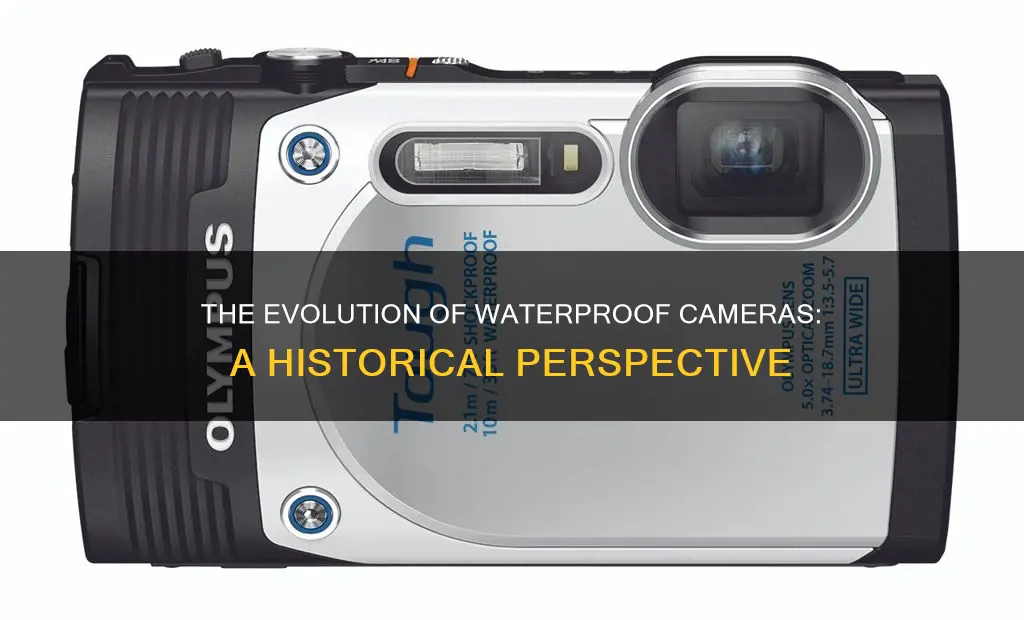
The first waterproof camera was invented in 1957 by Jean de Wouters, a Belgian engineer and former member of Jacques-Yves Cousteau's Calypso crew. The camera, an amphibious 35mm device, was marketed under the names Calypso and Calypso-Phot. The design was purchased by Nikon and re-released in 1963 as the Nikonos, which subsequently became a famous series of underwater cameras.
| Characteristics | Values |
|---|---|
| Date of invention | 1963 |
| Inventor | Jean de Wouters |
| Original name | Calypso |
| Re-released as | Nikonos |
What You'll Learn
- The first underwater photograph was taken in 1856 by William Thompson
- Louis Boutan was the first underwater photographer in 1893
- The first underwater colour photos were taken in 1923
- Beuchat produced the first commercially available camera housing, Tarzan, in 1950
- Jean de Wouters designed the first successful underwater commercial still camera, the Calypso, in 1957

The first underwater photograph was taken in 1856 by William Thompson
Thompson's innovation came less than 20 years after the first-ever recorded photograph. He used a wet collodion plate to capture the image, and his process was a technical success, though the resulting photograph was not a masterpiece. Thompson's image was also the first half-and-half image, or split shot, with half the photograph taken above water and the other half underwater.
Thompson's interest in underwater photography stemmed from his natural history studies, and he often used his camera to take still-life photographs of fish and other marine subjects. He designed a better apparatus for underwater photography but then lost interest and did not pursue the matter further. It was only at the urging of his friend William Penney, a chemist and naturalist, that he sent an account of his experiment to the Journal of the Society of Arts for publication.
The world's first underwater photograph was a significant milestone, paving the way for future developments in underwater imaging. Over a hundred years later, in 1957, the first generation of 35mm-format cameras specifically designed for underwater photography became available for purchase, marking the beginning of a revolution in underwater imaging.
Duracell AA Batteries: How Long Do They Power Cameras?
You may want to see also

Louis Boutan was the first underwater photographer in 1893
Louis Boutan was a French biologist and photographer who became the first underwater photographer in 1893. He was born in Versailles in 1859 and studied biology and natural history at the University of Paris. In 1880, he travelled to Australia to study marsupial embryology and identify new animal species. It was during this time that he first became interested in underwater photography, as he wanted to study molluscs in their natural environment.
Boutan's first dive took place in 1886 at the Arago Laboratory in Banyuls-sur-Mer, a village in southwestern France near the Spanish border. Here, he examined the molluscs that had captured his interest. However, it was only after he returned to Paris and joined Henri de Lacaze-Duthiers in 1891 that he began to develop his ideas about underwater photography.
Boutan faced two major challenges when attempting to take photographs underwater: pressure and light. To address these issues, he began experimenting with different techniques and technologies. With the help of his brother, Alfred, an engineer, he developed a waterproof housing for a small "detective" camera. This camera was placed in a copper box with a rubber balloon attached via a tube. As the box descended and the pressure increased, the balloon squeezed air into the box to equalise the pressure.
Boutan first tested this apparatus in 1893 but found the results disappointing, as the images were blurry and lacked clarity. He continued to experiment, using a blue filter to reduce cloudiness and moving to a different bay for better visibility. He also tried leaving the plates unprotected from the water, using specially varnished plates to counteract the effects of saltwater. However, these results were also unsatisfactory.
Boutan then returned to his original apparatus and made some adjustments. He replaced the copper box with an iron one and changed the lens to an astigmatic lens to account for refraction. These changes, however, made the apparatus heavier and bulkier, requiring three men to manoeuvre it. The new lens also needed to be carefully focused, which was achieved by lowering the camera just below the water surface using a pulley system.
To capture his underwater photographs, Boutan would dive to the seafloor and signal for the different parts of the apparatus to be lowered to him. Once everything was set up, he would signal for the exposure to begin and patiently wait for the pre-determined duration, which could be up to 30 minutes. Despite the challenges, Boutan's perseverance and passion for science and molluscs allowed him to make history in underwater photography.
Battery Life of Wireless Security Cameras: How Long?
You may want to see also

The first underwater colour photos were taken in 1923
Longley and Martin's pioneering work in underwater photography built on earlier innovations in camera technology. The history of the camera began even before the introduction of photography, with the camera obscura serving as the precursor to the photographic camera. Over time, cameras evolved from the camera obscura through various generations of photographic technology, including daguerreotypes, calotypes, dry plates, and film, eventually leading to modern digital cameras and camera phones.
The development of underwater photography specifically can be traced back to the mid-19th century, with the first underwater photographs taken in 1856 by William Thompson in Weymouth Bay, England. These early images were captured using a metal box housing for a camera, with exposures made on 4" by 5" glass plates, and the shutter activated by a line from the surface.
In 1893, Louis Boutan developed a crude housing for a small "detective"-type camera and captured the first diving photograph using a surface-supplied hard hat. Boutan recognised the limitations of natural light in underwater photography and pioneered the use of artificial light. He developed an underwater "strobe" consisting of an alcohol lamp in an oxygen-filled barrel, with a puff of magnesium to trigger a flash.
Building on these early advancements, Longley and Martin made their groundbreaking achievement in 1923, capturing the world's first underwater colour photographs. Their work opened up new possibilities for exploring and documenting the underwater world, paving the way for future innovations in underwater imaging technology.
The first amphibious camera designed specifically for underwater use was the Calypso, introduced in 1963 and later rebranded as the Nikonos. This camera marked a significant milestone in the history of underwater photography, offering dedicated equipment tailored for capturing images beneath the surface.
Charging Camera Batteries: Refuel's Quick and Easy Guide
You may want to see also

Beuchat produced the first commercially available camera housing, Tarzan, in 1950
In 1950, Beuchat produced the first commercially available camera housing, the Tarzan. The Tarzan was designed by French underwater photographer Henry Broussard for the French Foca camera. The Beuchat company was established in 1934 in the south of France by Georges Beuchat, an avid diver. The Tarzan was a significant innovation in underwater photography, paving the way for the development of amphibious 35mm underwater cameras and the famous Nikonos series, first released in 1963.
The Tarzan housing was initially created for the Foca Standard camera, a quality French 35mm photography camera available at a lower price point than the Leica. The Tarzan was manufactured circa 1947-1948, towards the end of World War II. The small production of Leica cameras and the high risk of flooding presented by underwater photography made the Foca camera an ideal choice for this innovation.
The Tarzan housing presented some limitations due to its design. Once the Foca camera was enclosed in the housing, it was impossible to modify the focus or adjust the diaphragm. The available controls were limited to two buttons: one to arm the camera by pressing and turning, and another to trigger the shutter. The Tarzan housing was made of moulded alloy, weighing 1.945 kg with its key and stopper. Its two-part construction, assembled with four nuts, ensured robustness and waterproofness.
In the second series of production, the Tarzan housing was adapted for Leica II cameras. Some units were sold to US soldiers stationed in Germany, where they could purchase Leicas at good prices.
The development of the Tarzan housing by Beuchat was a significant milestone in the history of underwater photography, making it possible for photographers to capture images underwater with a commercially available camera for the first time.
Mastering Blender's Camera Fly Mode for Animation
You may want to see also

Jean de Wouters designed the first successful underwater commercial still camera, the Calypso, in 1957
In 1957, Jean de Wouters, a Belgian engineer and former member of Jacques-Yves Cousteau's Calypso crew, designed the first successful underwater commercial still camera, the Calypso. De Wouters created the Calypso-Phot for Cousteau's company, La Spirotechnique, and it was later licensed to Nikon and re-released as the Nikonos in 1963. The Nikonos became a famous series of underwater cameras.
The Calypso was an amphibious 35mm underwater camera, waterproof by design and certified to a depth of 60 metres, though some users reported using it at depths of up to 120 metres without any issues. De Wouters' invention featured a unique waterproofing system, with the camera mechanism fitted vertically inside a rigid body and waterproofness achieved through the use of a large O-ring. The camera also included a colimated viewfinder, a depth of field scale, and flash synchronisation.
Another key innovation was the mounting of the lens in a special casing that ensured its waterproofness. The lens was mounted on springs, allowing the body to distort while maintaining the correct lens distance. De Wouters invented a special mobile bayonet that enabled the rigid body to deform while keeping the lens perfectly aligned.
The Calypso was a rare and sought-after camera, produced in very limited quantities, and it marked a significant milestone in the history of underwater photography. Its design was so revolutionary that Nikon engineers initially believed it could not have been conceived by a camera manufacturer.
Locking Camera to Portrait Mode in Swift 4
You may want to see also







